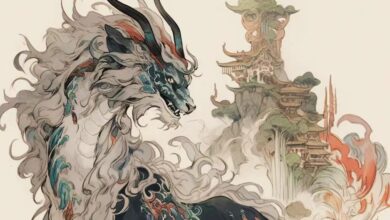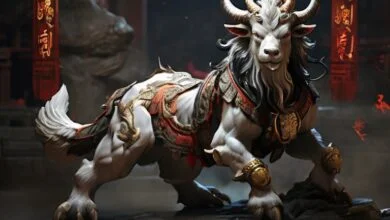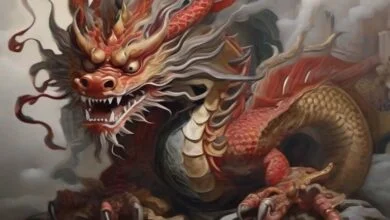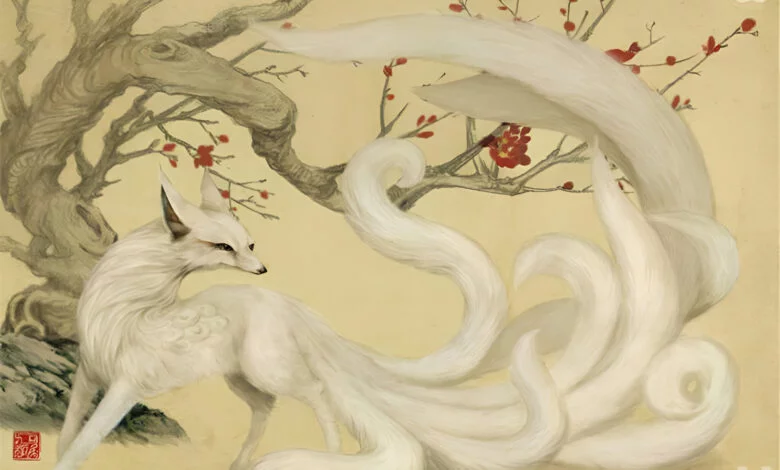
Table of Contents
The nine-tailed fox, or jiuweihu (九尾狐), is a mythical creature that has captivated Chinese culture for centuries. This enigmatic figure is more than just a mythical beast; it embodies a myriad of meanings and symbolisms, reflecting the cultural, social, and historical transformations of Chinese society. Over time, the nine-tailed fox has been depicted both as an auspicious figure and a deceitful trickster, with its most infamous association being the story of Daji, whose life and legend exemplify the complex relationship between myth and reality. This article explores the intricate evolution of the nine-tailed fox across different eras, examining how perceptions of this mythical creature have changed and what these shifts reveal about societal attitudes.
Origins in the Shanhaijing: An Auspicious Creature
The Shanhaijing, or the Classic of Mountains and Seas, is one of the oldest Chinese texts to mention the nine-tailed fox. Compiled during the Warring States period (475–221 BCE) and the early Han Dynasty, this text serves as a comprehensive guide to the mythological geography and creatures of ancient China. Within its pages, the nine-tailed fox is described as inhabiting the magical land of Qingqiu (青丘), portrayed as a creature with nine tails and a voice akin to a baby’s cry. Despite its eerie characteristics, the nine-tailed fox was seen as an auspicious being, believed to bring prosperity and peace to the lands it inhabited.
In these early narratives, the nine-tailed fox was revered rather than feared, symbolizing abundance and good fortune. Its presence indicated a harmonious balance between humans and nature, where mythical creatures played integral roles in the spiritual and natural world. The nine tails of the fox, in particular, were seen as a sign of its power and divine nature, representing the multifaceted aspects of life and existence.
Transformation During the Han Dynasty: From Symbol to Seductress
As Chinese society evolved, so too did its myths and legends. During the Han Dynasty (206 BCE – 220 CE), China experienced significant cultural consolidation and the rise of Confucianism as a dominant philosophical and ethical system. This era marked a period of increasing interest in literature and storytelling, with myths being recorded and disseminated widely thanks to the proliferation of paper and writing. As these stories spread, the image of the nine-tailed fox began to shift dramatically.
The Confucian ideals of the Han Dynasty emphasized social order, morality, and the maintenance of hierarchical relationships. Within this context, the nine-tailed fox transformed from a symbol of prosperity into a more sinister figure associated with deception and seduction. Stories began to emerge depicting the fox as a cunning shape-shifter, capable of taking human form—often as a beautiful woman—to ensnare and manipulate individuals. This narrative shift mirrored societal anxieties about female sexuality and autonomy, positioning the fox as both alluring and dangerous.
The transformation of the nine-tailed fox into a symbol of deceit was not just a reflection of gender dynamics but also represented broader cultural concerns about chaos and disorder. The fox’s ability to change form and disrupt social norms challenged the Confucian emphasis on stability and propriety, making it a potent metaphor for the dangers of unchecked desire and ambition.
The Legend of Daji: Myth Meets History
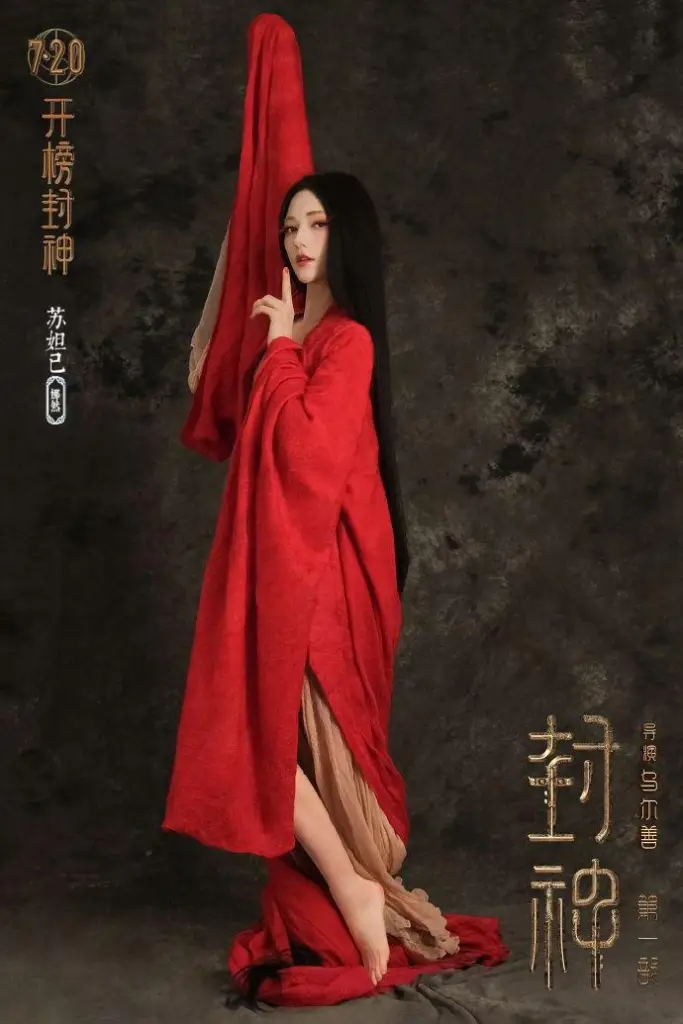
One of the most famous—and infamous—incarnations of the nine-tailed fox is the story of Daji, a historical figure from the Shang Dynasty. According to legend, Daji was a beautiful and favored consort of King Zhou of Shang, the last king of the Shang dynasty. Her story is detailed in later works such as The Investiture of the Gods (封神演义), where she is depicted as being possessed by a malevolent fox spirit. This possession, the legend goes, led her to seduce King Zhou and influence him to commit acts of extreme cruelty and decadence, ultimately resulting in the dynasty’s downfall.
Daji’s narrative serves as a cautionary tale, illustrating the dangers of female influence and the potential for moral decay when desire is left unchecked. Her portrayal as a seductive and malevolent figure reinforced negative stereotypes about women, depicting them as temptresses capable of leading men astray. This story became a powerful tool for reinforcing patriarchal norms, warning against the perceived threats posed by powerful women.
The legend of Daji is particularly significant because it intertwines myth and history, using the figure of the nine-tailed fox to explain the collapse of a dynasty. By attributing the fall of the Shang to the influence of a supernatural creature, these stories provided a moral explanation for historical events, reinforcing the idea that chaos and disorder are the result of moral failings.
Song and Tang Dynasties: Expanding Narratives and Nuanced Interpretations
The Tang (618–907) and Song (960–1279) dynasties were periods of great cultural flourishing in China, marked by a burgeoning interest in literature, art, and philosophy. During these eras, the figure of the nine-tailed fox became a popular subject in tales of the marvelous. These stories explored themes of love, deception, and the supernatural, often featuring the fox as a central characterer.
In Tang and Song literature, the portrayal of the nine-tailed fox became more nuanced, reflecting a broader range of interpretations. While some stories depicted the fox as a loyal and loving companion, others emphasized its deceptive and dangerous nature. This duality mirrored the complexities of human relationships and highlighted the tensions between desire and duty.
The fox spirit stories from these dynasties served not only as entertainment but also as moral lessons, offering insights into the human condition and the challenges of navigating societal expectations. By presenting the fox as both a benevolent and malevolent figure, these tales reflected the ambivalence towards female sexuality and power, suggesting a more sophisticated understanding of gender dynamics.
Modern Reinterpretations and Cultural Impact: Reclaiming the Nine-Tailed Fox
In contemporary times, there has been a shift towards reinterpreting the myth of the nine-tailed fox and the story of Daji. Modern scholars and artists have sought to reclaim these figures, challenging traditional narratives that depict them as purely negative forces. This reinterpretation emphasizes the complexity and agency of the nine-tailed fox, presenting it as a symbol of empowerment and resistance against patriarchal norms.
Exhibitions and literary works have highlighted the historical context of Daji’s demonization, suggesting that her portrayal as a villainous fox spirit served to reinforce male-dominated narratives. By examining her story through a modern lens, these reinterpretations challenge the simplistic dichotomy of good and evil, emphasizing the nuanced nature of myth and its impact on cultural identity.
The nine-tailed fox has also gained prominence in popular culture, appearing in films, games, and novels as a symbol of transformation and mystery. This enduring fascination reflects its ability to adapt and resonate across different cultural contexts, underscoring the timeless allure of mythological storytelling. In media, the nine-tailed fox often appears as a powerful and independent character, representing themes of transformation, mystery, and the reclaiming of feminine power.
The Nine-Tailed Fox in Popular Culture
Today, the nine-tailed fox is a popular motif not only in Chinese culture but also in other East Asian traditions, such as Japanese and Korean folklore. Known as the kitsune in Japan and the gumiho in Korea, these creatures share similarities with the Chinese nine-tailed fox but also exhibit unique regional traits. In each culture, the fox spirit is often depicted as a clever, magical creature capable of transformation and possessing a range of magical abilities.
In Japanese folklore, the kitsune is seen as a messenger of the god Inari and is sometimes considered a benevolent protector. However, like its Chinese counterpart, the kitsune can also be a trickster, using its powers to deceive humans. This duality is a testament to the complex nature of the fox spirit, which embodies both positive and negative qualities.
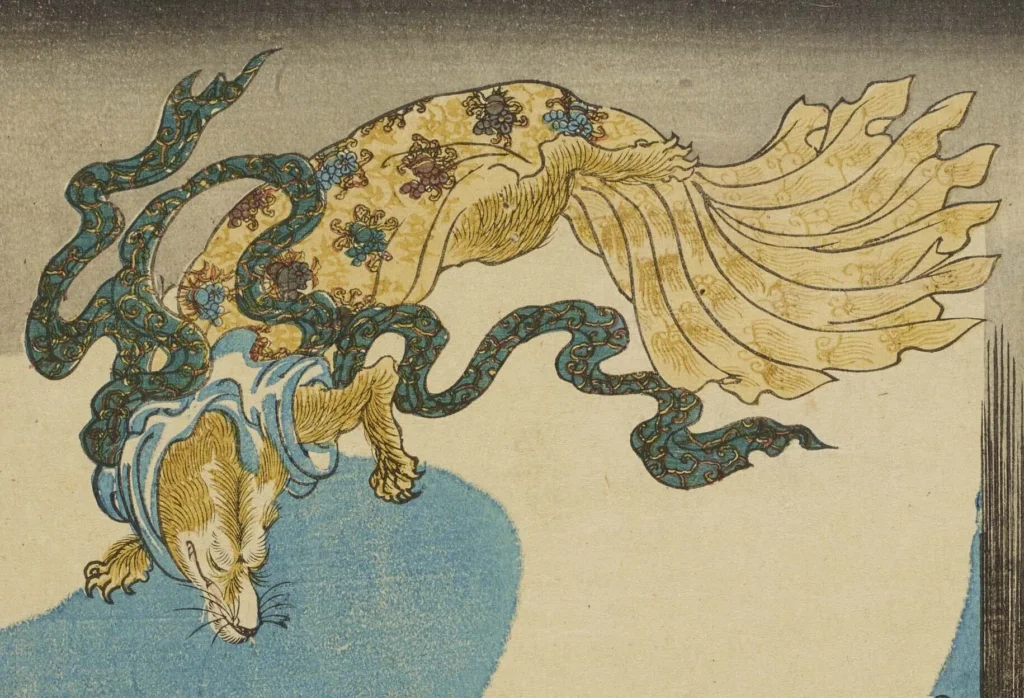
The nine-tailed fox has also found its way into modern media, from films and television series to video games and literature. Characters inspired by the nine-tailed fox often possess qualities such as intelligence, allure, and the ability to manipulate their surroundings. These portrayals reflect contemporary interest in themes of transformation, power, and the exploration of identity.
Reclaiming the Narrative: Feminist and Postcolonial Perspectives
The reinterpretation of the nine-tailed fox in modern contexts often intersects with feminist and postcolonial perspectives, challenging the traditional narratives that have demonized the fox and its associated figures, such as Daji. By reexamining these stories, scholars and artists highlight the ways in which myth can be used to reinforce or challenge dominant cultural norms.
From a feminist perspective, the story of Daji and the nine-tailed fox can be seen as a critique of patriarchal structures that seek to control and demonize female power. By portraying Daji as a seductive and dangerous figure, traditional narratives have often positioned women as threats to male authority. Modern reinterpretations seek to reclaim Daji’s story, presenting her as a complex figure who defies simplistic categorization.
Similarly, from a postcolonial perspective, the nine-tailed fox can be seen as a symbol of resistance against cultural hegemony. By reclaiming the fox as a positive and empowering figure, contemporary narratives challenge the cultural and historical forces that have sought to control and define marginalized identities. In this way, the nine-tailed fox serves as a powerful symbol of cultural resilience and transformation.
Conclusion
The nine-tailed fox remains a potent and enduring symbol in Chinese mythology, embodying the intricate interplay between myth, culture, and history. From its ancient roots in the Shanhaijing to its role in the cautionary tale of Daji, the fox spirit’s evolution mirrors broader societal changes and attitudes towards women, power, and morality. Today, the nine-tailed fox continues to inspire and intrigue, offering rich narratives that explore the depths of human experience and imagination.
Through its various interpretations, the nine-tailed fox challenges us to reconsider the boundaries between myth and reality, inviting us to explore the complexities of identity and transformation in the context of cultural heritage. As both a symbol of auspiciousness and a cautionary tale, the nine-tailed fox remains a powerful figure that transcends time and space, reflecting the ever-changing nature of human society and the stories we tell.
